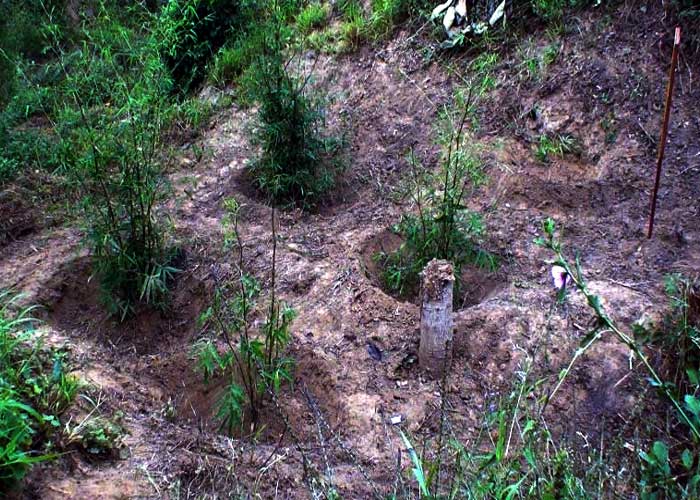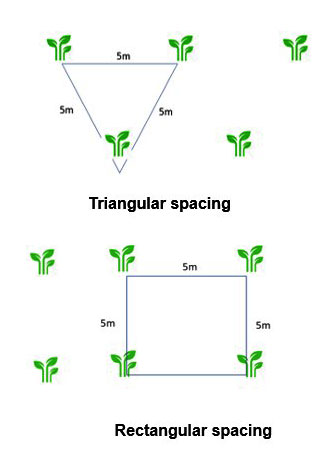Spacing is one of the important aspects of the cultivation of bamboos. It is related to the nature of the rhizome, the diameter of the culm, growth parameters, purpose of plantations (shoot production, timber, charcoal, paper pulp stands), agro-climatic factors, etc. Adequate space between bamboo plants should be given to reduce competition for light, water, soil nutrients, etc., however, it is not advisable to give spacing too wide, as the plantation tends to suffer from canopy exposure, loss of soil moisture through evaporation, and luxuriant growth of weeds increase the risk of fire and its affect the productivity also in terms of less number of clumps per hectare.
A spacing of 8 x 8 m and 8 x 6 m with 150 clumps and 200 clumps is suggested for large bamboo plants. The spacing for the sympodial species like Dendrocalamus latiflorus, D. hamiltonii and Bambusa beecheyana can be planted at the spacing of 4 x 5 m or 5 x 5 m, with each clump contents 6 to 8 culms of 1 to 2 years of age.*1,2

For sympodial species for pulp and paper stands, the recommended spacing can be 3 x 4 m, 4 x 4 m, and 4 x 5 m*1. For the production of timber stands, the proposed stand density for species Dendrocalamus strictus and Bambusa bambos is 700 clumps per hectare, each clump containing 10 to 20 culms at 1 to 3 years of age*1. In the case of bamboo shoot stands, standing culm density can be from 9000 to 12000 culms per hectare for medium and small-sized monopodial bamboos. The high-density plantations (2500 plants/ha) are used mainly in the form of energy as biomass for Power generation, Bio-Ethanol, etc.,
In short, depending on the clump size, the species can be classified as small (up to 15 m tall with a clump diameter of 1-3m), medium (15-20 m tall with a clump diameter of 3-5m) and large (20-30 m tall with a clump diameter of 5-8 m) clumps. For larger bamboos like Dendrocalamus giganteus low planting density with wider spacing and in the case of small sized higher density with close spacing is suggested. The spacing can be as follows:
- If the objective of planting is to prevent soil erosion or stabilization of river banks, 2 × 2 to 3 × 3 m spacing is sufficient along with other
- In the case of small-diameter bamboos 4 × 4 m is recommended (e.g. Bambusa multiplex, Dendrocalamus strictus, D. stocksii, Oxytenanthera abyssinica, Pseudoxytenanthera ritcheyi Thyrsostachys oliveri).
- Spacing of 5 × 5 to 7 × 7 m is ideal for medium-diameter bamboo (8–15 cm): (Bambusa balcooa, B. tulda, B. polymorpha, B. vulgaris, Dendrocalamus asper, D brandisii, D hamiltonii, D. longispathus, D. membranaceus, Cephalostachyum pergracile, Yushania alpina, etc.).
- 7 × 7 to 10 × 10 m: Large-diameter bamboo: >15 cm (B. bambos, Dendrocalamus giganteus).
- If the objective is erosion control along river banks or landslide protection, the spacing can be 3 x 3 m or even 2.5 x 2.5 m. In such cases, bamboo can be interspersed with appropriate, fast-growing other timber species.
Two patterns of spacing can be employed, Rectangular spacing and Triangular spacing, in which the even-numbered rows are midway between those in the odd rows instead of opposite them. Triangular spacing is recommended for large-scale commercial planting which helps to maintain an equal distance between rows of plants for intercropping and further clump maintenance.
The next step is to align and place stakes to mark spots for taking the pits for planting. A North-South orientation is ideal for aligning the rows for most sun exposure and also allows for ample air circulation. This can be done just a few weeks above before planting operations and the exact spots to be dug can be marked using bamboo sticks or splits. Digging operations two weeks before planting will facilitate the withering of soil.
The size of the pit should be 60 × 60 × 60 to 100 × 100 × 100cm for planting rhizomes and 30 × 30 × 30 to 45 × 45 × 45cm for seedlings and culms. In the case of lateritic or coastal areas, it is advisable to plant bamboo in 60 × 60 × 60cm to 1 x 1 x 1 m pits enriched with fertile soil, compost, and green manure. The early rainy season is the ideal time for bamboo planting. To ensure proper growth, manure and fertilizer (5 kg of manure/compost) can be applied and it should be properly mixed with topsoil.
While planting, the polybags can be removed and after placing bamboo plants on the pit, the topsoil mixture can be filled on the sides; then filling the bottom soil above it. After preparing soil mount around the plant a small trenching around the pits helps to enable water availability. The post-planting operations include casualty replacement, maintenance of culms and clumps, maintenance of soil, mounding; mulching, weeding, pest and insect control, pruning, etc.

*1. Fu and Banik, 1996;
*2 Jiang, 2007
